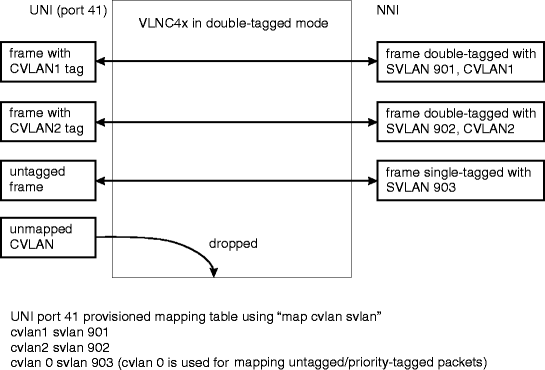Procedure 13-2: Configure service-multiplexing on VLNC4x
 Overview
Overview
Use this procedure to configure Ethernet service-multiplexing and bundling capabilities of Ethernet Virtual Connections (EVCs) on the VLNC4x. See Figure 13-1, Service-multiplexing concept.
Ethernet service-multiplexing involves mapping incoming single-tagged Customer VLAN (CVLAN) packets into double-tagged service provider VLAN (SVLAN) packets, preserving all the customer VLAN information. Untagged packets may also be mapped to an SVLAN using 0 (zero) as a special CVLAN for mapping untagged or priority-tagged packets. Every incoming packet receives a per-port provisionable default VLAN (DVLAN, provisioned using the vlan pvid <vlanid> command), unless it already had a tag with the DVLAN.
Important!
Each NNI can only communicate with service-multiplexing UNIs, or with non-service-multiplexing UNIs, but not with both. As soon as an NNI is configured to communicate with a service-multiplexing UNI (due to mappings and vlan participation), it ceases to be able to communicate with a non-service-multiplexing UNI. There are no command denials or warnings when this occurs. NNIs may communicate with all other NNIs, and UNIs may communicate to all other UNIs (whether service-multiplexed or not).
Refer to the Alcatel-Lucent 1850 Transport Service Switch (TSS-5) Command Line Interface Guide, for help on using CLI commands.
 Before you begin
Before you begin
You must know the following:
-
The VLNC4x ports participating in service-multiplexing, and which ports are the UNI or NNI ports.
-
The VLAN IDs for all CVLANs, SVLANs, and DVLANs (if required).
-
The mapping required between the CVLANs and SVLANs.
Reference the following rules, definitions, and commands:
-
NNI — Network-Network Interface. When using service-multiplexing, the NNIs must be provisioned on d-group Ethernet ports. A port becomes an NNI when double VLAN tagging is enabled on the interface port.
-
UNI — User Network Interface. When double VLAN tagging is enabled on any d-group interface port, a-group and d-group ports that do not have double VLAN tagging enabled become UNI ports. In this procedure, a UNI generally corresponds to an a-group Ethernet port.
-
mode dvlan-tunnel — This command enables double VLAN tagging on an interface port.
-
service-multiplexing — Enables a specified customer port interface (UNI) to support the service-multiplexing attribute. Service-multiplexing may only be enabled on UNI ports (ports where double VLAN tagging is not enabled.) Service-multiplexing may not be enabled on a port unless there is at least one port on the shelf where double VLAN tagging is enabled.
When service-multiplexing is enabled, the port vlan ID (pvid), (default VLAN ID [DVLAN]), is overwritten by a customer specified service provider VLAN ID (SVLAN) based on the customer VLAN ID (CVLAN) of the ingress packet using the map <cvlan> <svlan> command.
-
map <cvlan> <svlan> — Specifies the outer service provider VLAN (svlan) tag to use, based on an ingress packet’s customer VLAN (cvlan) tag. All mapped cvlan and svlan tags are automatically added to the interface’s VLAN participation include list. All unmapped tags are filtered in both directions.
Mapping is only allowed on UNI interfaces where “service-multiplexing” is enabled.
A CVLAN may only be mapped to a single SVLAN. Multiple CVLANs may be mapped to one SVLAN. Both the CVLAN and SVLAN must first have been created using the vlan <vlanid> command in the VLAN database, except for special cases where CVLAN 0 is used for mapping untagged or priority tagged packets.
Figure 13-1: Service-multiplexing concept

Step
1 |
Login to the VLNC4x at the node you are provisioning. Result: The User EXEC prompt [(ALU switching)>] displays. |
2 |
Perform the following as required:
End of steps |